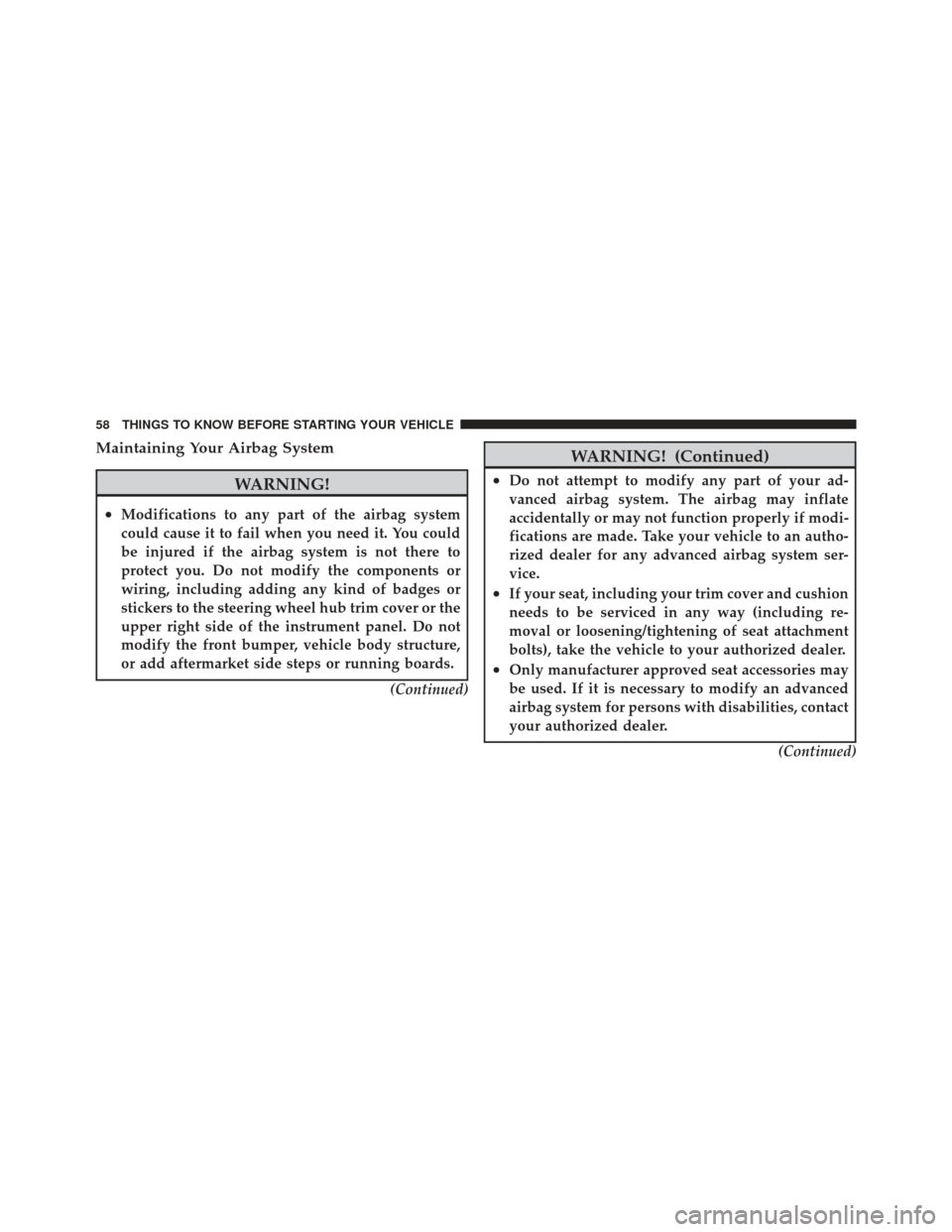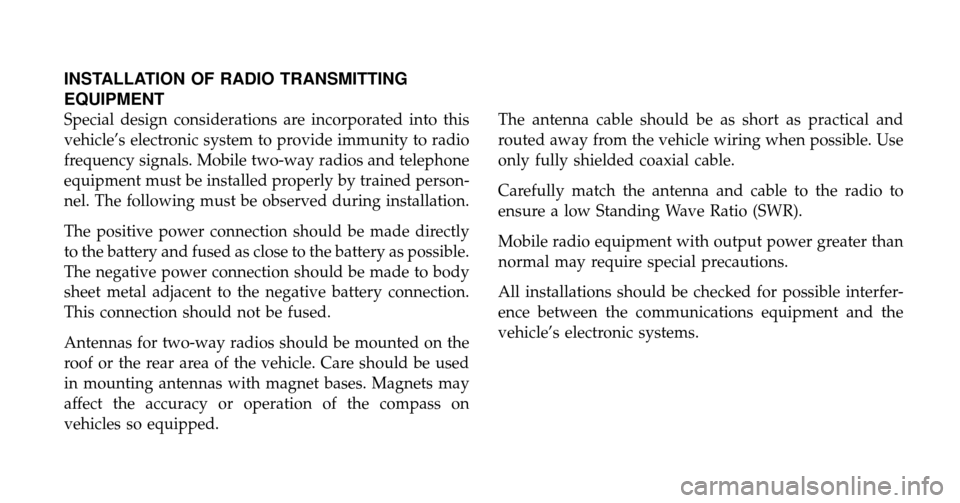Page 51 of 410

The front airbag system consists of the following:
•Occupant Restraint Controller
•Side Remote Acceleration Sensors (If equipped)
•Airbag Warning Light
•Driver Airbag
•Passenger Airbag
•Front Seat Mounted Side Airbags (If equipped)
•Steering Wheel and Column
•Instrument Panel
•Interconnecting Wiring
•Knee Impact Bolsters
•Driver Inflatable Knee Blocker
•Front Acceleration Sensors
•Driver and Front Passenger Seat Belt Pretensioners
•Occupant Classification System (OCS) for the Front
Passenger Seat
�Occupant Classification Module
�Passenger Airbag Disable (PAD) Indicator Light
�Weight Sensors
How The Airbag System Works
•
TheOccupant Restraint Controller (ORC) determines
if a frontal collision is severe enough to require the
airbags to inflate. The front airbag inflators are de-
signed to provide different rates of airbag inflation
from direction provided by the ORC. The ORC may
also modify the rate of inflation based on the occupant
size provided by the Occupant Classification Module.
The ORC will not detect roll over.
2
THINGS TO KNOW BEFORE STARTING YOUR VEHICLE 49
Page 60 of 410

Maintaining Your Airbag System
WARNING!
•Modifications to any part of the airbag system
could cause it to fail when you need it. You could
be injured if the airbag system is not there to
protect you. Do not modify the components or
wiring, including adding any kind of badges or
stickers to the steering wheel hub trim cover or the
upper right side of the instrument panel. Do not
modify the front bumper, vehicle body structure,
or add aftermarket side steps or running boards.(Continued)
WARNING! (Continued)
•Do not attempt to modify any part of your ad-
vanced airbag system. The airbag may inflate
accidentally or may not function properly if modi-
fications are made. Take your vehicle to an autho-
rized dealer for any advanced airbag system ser-
vice.
•If your seat, including your trim cover and cushion
needs to be serviced in any way (including re-
moval or loosening/tightening of seat attachment
bolts), take the vehicle to your authorized dealer.
•Only manufacturer approved seat accessories may
be used. If it is necessary to modify an advanced
airbag system for persons with disabilities, contact
your authorized dealer.(Continued)
58 THINGS TO KNOW BEFORE STARTING YOUR VEHICLE
Page 289 of 410
Towing Requirements — Trailer Lights And Wiring
Whenever you pull a trailer, regardless of the trailer size,
stop lights and turn signals on the trailer are required for
motoring safety.
The Trailer Tow Package may include a four–or seven-pin
connector wiring harness. Use a factory approved trailer
harness and connector.
NOTE:Do not cut or splice wiring into the vehicles
wiring harness.
The electrical connections are all complete to the vehicle
but you must mate the harness to a trailer connector.
Refer to the following four-pin connector and seven-pin
connector illustrations.
Four-Pin Connector
1 — Female Pins 4 — Park
2 — Male Pin 5 — Left Stop/Turn
3 — Ground 6 — Right Stop/Turn
5
STARTING AND OPERATING 287
Page 406 of 410

Compact Spare........................ 259
General Information .................... 256
High Speed .......................... 259
Inflation Pressures ..................... 257
Jacking ............................. 294
Life of Tires .......................... 262
Load Capacity ..................... 252,253
Pressure Monitor System (TPMS) ........... 265
Pressure Warning Light .................. 165
Quality Grading ....................... 387
Radial .............................. 259
Replacement ......................... 262
Rotation ............................ 264
Safety ........................... 248,256
Sizes ............................... 249
Snow Tires ........................... 264
Spare Tire ........................... 295
Spinning ............................ 260
Tread Wear Indicators ................... 261 Tongue Weight/Trailer Weight
.............. 282
Towing ............................... 278
24-Hour Towing Assistance ................ 96
Disabled Vehicle ....................... 303
Guide .............................. 282
Recreational .......................... 290
Weight .............................. 282
Towing Assistance ........................ 96
Traction .............................. 237
Traction Control ......................... 246
Traction Control Switch ................... 246
Trailer Towing .......................... 278
Cooling System Tips .................... 290
Hitches ............................. 281
Minimum Requirements ................. 283
Trailer and Tongue Weight ............... 282
Wiring .............................. 287
Trailer Towing Guide ..................... 282
Trailer Weight .......................... 282
404 INDEX
Page 409 of 410

INSTALLATION OF RADIO TRANSMITTING
EQUIPMENT
Special design considerations are incorporated into this
vehicle’s electronic system to provide immunity to radio
frequency signals. Mobile two-way radios and telephone
equipment must be installed properly by trained person-
nel. The following must be observed during installation.
The positive power connection should be made directly
to the battery and fused as close to the battery as possible.
The negative power connection should be made to body
sheet metal adjacent to the negative battery connection.
This connection should not be fused.
Antennas for two-way radios should be mounted on the
roof or the rear area of the vehicle. Care should be used
in mounting antennas with magnet bases. Magnets may
affect the accuracy or operation of the compass on
vehicles so equipped.The antenna cable should be as short as practical and
routed away from the vehicle wiring when possible. Use
only fully shielded coaxial cable.
Carefully match the antenna and cable to the radio to
ensure a low Standing Wave Ratio (SWR).
Mobile radio equipment with output power greater than
normal may require special precautions.
All installations should be checked for possible interfer-
ence between the communications equipment and the
vehicle’s electronic systems.